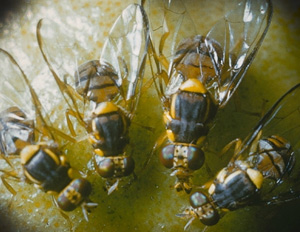Oriental Fruit Fly Quarantine Expands in Northern California
New Quarantine Measures 123 Square Miles
News Release Edited By Patrick Cavanaugh
A portion of Sacramento and Yolo Counties have been placed under quarantine for the Oriental fruit fly following the detection of 15 flies in and around the southern part of the City of Sacramento near the Lemon Hill community.
The quarantine zone measure 123 square miles, generally bordered on the north by El Camino Avenue; on the south by Laguna Boulevard, on the west by the Sacramento River; and on the east by Bradshaw Road. A link to the quarantine map may be found here: https://www.cdfa.ca.gov/plant/off/regulation.html.
To prevent the spread of Oriental fruit flies through homegrown fruits and vegetables, residents living in the quarantine area are urged not to move those items from their property. However, they may be consumed or processed (i.e. juiced, frozen, cooked, or ground in the garbage disposal) on the property where they were grown, or disposed of by double-bagging and placing in the regular trash bin, not green waste.
Following the principles of Integrated Pest Management (IPM), CDFA primarily uses the “male attractant” technique to eradicate this pest. Trained workers squirt a small patch of fly attractant mixed with a very small dose of pesticide approximately 10 feet off the ground on street trees and similar surfaces; male fruit flies are attracted to the mixture and perish after consuming it. This approach has successfully eliminated dozens of fruit fly infestations from California over the last several decades.
The Oriental fruit fly is known to target 230 different fruit, vegetable, and plant commodities. Damage occurs when the female fruit fly lays her eggs inside the fruit.
Small larvae generally enter the fruit at the stem end, although entry can be made anywhere on the fruit, particularly where two fruits touch. Larvae immediately bore to the center of the fruit and feed around the pit. After reaching maturity, they exit from the fruit and pupate.
While fruit flies and other invasive species that threaten California’s crops and natural environment are sometimes detected in agricultural areas, the vast majority are found in urban and suburban communities.
The most common pathway for these pests to enter the state is by “hitchhiking” in fruits and vegetables brought back illegally by travelers when they return from infested regions of the world or ship infested produce through the mail. Help protect California’s agricultural and natural resources; please Don’t Pack a Pest (www.dontpackapest.com) when traveling or mailing packages.
The Oriental fruit fly is widespread throughout much of the mainland of southern Asia and neighboring islands, including Sri Lanka and Taiwan, and it has invaded other areas, most notably Africa and Hawaii.
Residents with questions about the project may call CDFA’s Pest Hotline at 1-800-491-1899. Additional information may be found here: https://www.cdfa.ca.gov/plant/off/.










